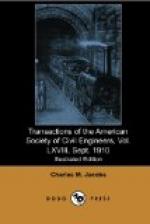A rearrangement of the gas pipes in the three streets crossing the Terminal site was necessary. These pipes were of two classes: trunk mains and service mains. Fortunately, there were but two trunk mains in the three streets, one a 20-in. in 31st Street from east of Seventh Avenue to Ninth Avenue, the other a 16-in. in 32d Street from east of Seventh Avenue to Eighth Avenue. The 20-in. main was relaid from Seventh Avenue and 31st Street down Seventh Avenue to 30th Street and through that street to Ninth Avenue. The 16-in. main was relaid from Seventh Avenue and 32d Street north to 34th Street and through that street to Eighth Avenue. The service mains in 32d Street were no longer required, and were taken up and not replaced. The houses on 31st and 33d Streets were provided with service by two 6-in. wrought-iron mains back of the retaining walls in each street, that location being chosen to avoid damage by gas drip to the water-proofing of the street bridges. As the permanent structures under the avenues were not to approach the surface nearer than 19 ft., only slight rearrangements, sufficient to permit the new sewers and water lines to be laid, were necessary.
There were no large water mains to be cared for, in fact, those in the streets were too small for ample fire protection, being only 6 in. in diameter. The main in 32d Street was taken up and not replaced, and those on 31st and 33d Streets were replaced by 12-in. pipes laid back of the retaining walls. No changes were necessary in the mains in the avenues, but, before approving the rearrangement for the streets, the Department of Water Supply, Gas and Electricity added a 48-in. main in Eighth Avenue to be laid as a part of this construction, the pipe being supplied by the City.
LOCATION AND DESIGN OF RETAINING WALLS.
The plans, from the earliest stages, contemplated founding the retaining wall on the surface of the rock, where of suitable quality, and afterward excavating the rock in front of the toe of the wall to sub-grade. This plan was definitely adopted soon after the borings were completed, on account of the great danger of blasting out large quantities of rock in timbered trenches close to buildings founded on soft material, and also to avoid the additional cost and delay that would have been caused by carrying the walls to sub-grade. The retaining walls in Seventh Avenue, south of the viaduct, and in Ninth Avenue, north of the viaduct, were not governed by the same conditions as in the streets. The dip and quality of the rock at both points required that the walls be carried to sub-grade, and they are, in fact, face walls; the Ninth Avenue wall, in particular, having little thrust to sustain, is very light.
The results aimed at in the design and location of the retaining walls in 31st and 33d Streets were:
First.—A perfectly stable
wall under all conditions that might
reasonably be expected;




